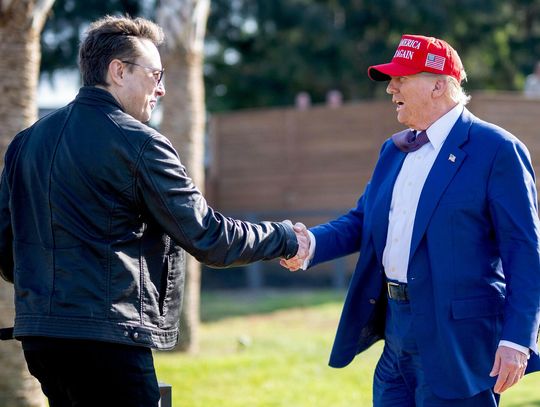Porozumienie Stanów Zjednoczonych, Polski i Ukrainy o współpracy w sferze energetyki to kolejna odsłona amerykańsko-rosyjskiej wojny o rynek węglowodorów w Europie Środkowej i Wschodniej. To odpowiedź na współpracę Moskwy z Berlinem i plan uczynienia z Niemiec hubu rozprowadzającego gaz rosyjski. Konkurencyjnym hubem, ale rozprowadzającym gaz amerykański, może stać się Polska. Na czym skorzystają nie tylko USA, nie tylko Polska, ale też inne kraje regionu – zyskując alternatywę dla gazu rosyjskiego.
Polska pod rządami Prawa i Sprawiedliwości konsekwentnie zmniejsza uzależnienie do gazu z Rosji. Budowany jest Baltic Pipe łączący Polskę ze złożami skandynawskimi, ale przede wszystkim, od kilku lat, największa firma gazowa w kraju, Polskie Górnictwo Naftowe i Gazownictwo (PGNiG) systematycznie zwiększa import LNG do terminalu w Świnoujściu. Należy pamiętać, że koncepcja gazoportu powstała za poprzednich rządów Prawa i Sprawiedliwości, a kluczową rolę odegrał śp. Lech Kaczyński. Teraz terminal jest rozbudowywany, a PGNiG podpisuje kolejne umowy na import gazu skroplonego. Do Polski sprowadza się LNG już nie tylko z Kataru, ale w coraz większym stopniu jest to gaz amerykański. Co ważne, ta coraz ściślejsza gazowa współpraca polsko-amerykańska nie tylko zwiększa niezależność energetyczną Polski, ale też będzie najważniejszym, kluczowym elementem amerykańskiej strategii zapewnienia krajom Europy Środkowej i Wschodniej gazu z USA.
Oczywiście jest to przedsięwzięcie biznesowe, mające przynosić zyski firmom amerykańskim, ale też ma ono ogromne znaczenie geopolityczne. Zwiększa bezpieczeństwo energetyczne całej Europy Środkowej i Wschodniej i uderza w do niedawna niemalże monopolistyczną gazową pozycję Rosji w tej części kontynentu. Administracja Donalda Trumpa otwarcie walczy z groźnymi dla niezawisłości państw naszego regionu energetycznymi wpływami Rosji. Z jednej strony podkreśla szkodliwość Nord Stream 2 i nie wyklucza nałożenia sankcji uderzających w ten projekt. Ale teraz przeszła też do ofensywy, oferując coraz większe ilości własnego gazu – alternatywy dla surowca od Gazpromu. Nieważne, czy tego sprowadzanego bezpośrednio z Rosji, czy za pośrednictwem rynku niemieckiego.
Amerykanie w regionie
Podróż Johna Boltona do kolejno Kijowa, Kiszyniowa, Mińska i Warszawy sugeruje, że USA widzą w ogromnej przestrzeni między Bałtykiem a Morzem Czarnym potencjał stworzenia grupy państw zdolnych współpracować ze sobie politycznie i, przede wszystkim, ekonomicznie. Jeśli chodzi o ten drugi aspekt, jednym ze zworników tego wschodnioeuropejskiego bloku mają być dostawy ropy i gazu z Ameryki. Należy pamiętać, że Polska już od dawna sprowadza amerykański LNG, a niedawno na Ukrainę trafiła pierwsza dostawa amerykańskiej ropy naftowej. Co więcej, nawet Białoruś zaczyna wyrażać zainteresowanie ropą z USA. To właśnie współpraca z Mińskiem może okazać się najtrudniejsza, ale trudno nie dostrzec ogromnej wagi spotkania doradcy prezydenta USA ds. bezpieczeństwa narodowego z prezydentem Alaksandrem Łukaszenką – oraz nie mniej istotnej wizyty sekretarza Rady Bezpieczeństwa Białorusi i wiceministra spraw zagranicznych Białorusi w Warszawie akurat w czasie, gdy stolica Polski znalazła się w centrum uwagi świata z racji uroczystości 80. rocznicy wybuchu II wojny światowej. W siedzibie polskiego Biura Bezpieczeństwa Narodowego odbyło się 31 sierpnia spotkanie prezydenckich doradców ds. bezpieczeństwa narodowego Polski, Stanów Zjednoczonych, Białorusi i Ukrainy poświęcone sytuacji w Europie Środkowej i Wschodniej oraz „omówieniu mechanizmów budowy stabilności w regionie służącej zapewnieniu suwerenności, bezpieczeństwa i integralności terytorialnej państw”.
Jeśli zaangażowanie Białorusi w regionalny format współpracy energetycznej konkurencyjny dla Rosji to jeszcze kwestia odległej przyszłości (jeśli w ogóle), to współpraca w trójkącie USA-Polska-Ukraina staje się faktem. W Warszawie wiceprezydent USA Mike Pence spotkał się z prezydentem Ukrainy Wołodymyrem Zełenskim. Według nieoficjalnych doniesień, Pence miał postawić szereg warunków, które Kijów powinien spełnić przed spotkaniem Zełenskiego z Trumpem. Jednym z nich poprawa relacji z Polską, a inny to dopuszczenie amerykańskich koncernów energetycznych na ukraiński rynek. Nie mniej ważne od dopuszczenia Shella czy Chevronu do eksploatacji złóż węglowodorów na Ukrainie jest jednak porozumienie, które podpisano 31 sierpnia w Warszawie właśnie.
Polski hub gazowy
Głównym celem memorandum o trójstronnej współpracy w sferze energetyki ma być zmniejszenie zależności państw regionu od Rosji. Z dokumentu wynika, że Ukraina będzie mogła przyjmować do 6 mld m³ amerykańskiego gazu rocznie. W jaki sposób? Gaz będzie dostarczany do Świnoujścia, a potem, przez Polskę, trafi na Ukrainę. W tym celu ma być zbudowane specjalne połączenie systemów gazowych Polski i Ukrainy. Reprezentujący USA sekretarz ds. energetyki Rick Perry nazwał podpisanie memorandum „nadzwyczajnym zwycięstwem bezpieczeństwa energetycznego, bezpieczeństwa ekonomicznego i bezpieczeństwa narodowego wszystkich trzech krajów”. Sekretarz Rady Bezpieczeństwa Narodowego i Obrony Ukrainy Ołeksandr Danyluk zauważył, że Ukraina nie kupuje gazu od Gazpromu już od kilku lat. – Następnym krokiem jest uzyskanie dostępu do LNG, gazu, którym głównie przypływa z USA – powiedział.
Porozumienie to oznacza przekształcenie Polski w gazowy hub, przez który Amerykanie będą mogli sprzedawać swój LNG do sąsiednich krajów. Niewykluczone, że po Ukrainie będzie to Białoruś. Mińsk bierze pod uwagę możliwość zakupu amerykańskiego LNG przez Polskę. Nie wiadomo bowiem, jak skończą się jesienne rozmowy z Moskwą o cenach gazu dla Mińska w następnych latach (teraz Białoruś płaci Gazpromowi 127 dolarów za 1 tys. m³). Tak samo mówi się imporcie amerykańskiej ropy przez Białorusinów. Niedawno państwowy koncern naftowy BNK zatrudnił amerykańskiego lobbystę, którego głównym zadaniem w Waszyngtonie ma być doprowadzenie do osłabienia sankcji i porozumienie się ws. eksportu amerykańskiej ropy na Białoruś. Chodzi m.in. o uzyskanie dla Białorusinów licencji od administracji USA na „zakup ropy naftowej z dostawą do rafinerii Białorusi”. Białoruś już w przeszłości próbowała zdywersyfikować źródła importu ropy naftowej – były dostawy surowca z Wenezueli i z Azerbejdżanu. Pomysł zakupu ropy naftowej akurat z USA, i to w czasie nasilającej się wojny węglowodorowej Ameryki z Rosją, jest kolejnym wyzwaniem dla Moskwy. Widać wyraźnie, że czekają ich ogromne kłopoty z utrzymaniem pozycji na rynkach Europy Środkowej i Wschodniej. Łupkowy boom za oceanem powoduje bowiem, że na rynek trafia coraz więcej gazu i ropy. Wpływa to na globalną obniżkę cen węglowodorów (to uderza w budżet rosyjski), ale też czyni amerykański surowiec w Europie coraz bardziej konkurencyjnym dla rosyjskiego.
Grzegorz Kuczyński
dyrektor programu Eurasia w Warsaw Institute. Ukończył historię na Uniwersytecie w Białymstoku i specjalistyczne studia wschodnie na Uniwersytecie Warszawskim. Ekspert ds. wschodnich, przez wiele lat pracował jako dziennikarz i analityk. Jest autorem wielu książek i publikacji dotyczących kuluarów rosyjskiej polityki.
The Warsaw Institute Foundation to pierwszy polski geopolityczny think tank w Stanach Zjednoczonych. Strategicznym celem tej organizacji jest wzmocnienie polskich interesów w USA przy jednoczesnym wspieraniu unikalnego sojuszu między dwoma narodami. Jej działalność koncentruje się na takich zagadnieniach jak geopolityka, porządek międzynarodowy, polityka historyczna, energetyka i bezpieczeństwo militarne. The Warsaw Institute Foundation została założona w 2018 roku i jest niezależną organizacją non-profit, inspirowaną bliźniaczą organizacją działającą w Polsce – Warsaw Institute.
The Warsaw Institute Foundation is Poland's first geopolitical think tank in the United States. The strategic goal of this organisation is to bolster Polish interests in the U.S. while supporting the unique alliance between the two nations. Its activity focuses on such issues as geopolitics, international order, historical policy, energy, and military security. Established in 2018, The Warsaw Institute Foundation is an independent, non-profit organization inspired the twin Poland-based Warsaw Institute.
Reklama











